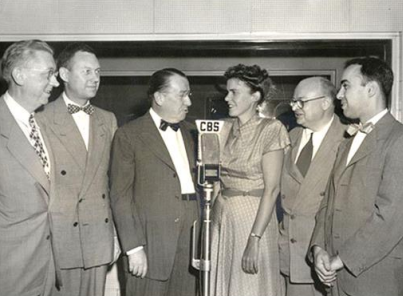Dr. David Bodian: Unsung Hero of Polio Eradication
Dr. David Bodian, was a medical scientist and teacher whose work helped lay the groundwork for both the Salk and Sabin polio vaccines. Born in St. Louis, Missouri, in 1910, Bodian attended the University of Chicago receiving both his PhD and MD (1937). His earlier contribution was to the method of staining nerve tissue.
He joined the Johns Hopkins School of Hygiene and Public Health in 1942. His noted colleagues, who also studied poliomyelitis, were Howard A. Howe and Isabel M. Morgan.1)(2) He joined the School of Medicine at Johns Hopkins in 1939 to teach and do research and received an additional appointment to the faculty of the School of Public Health three years later. In the 1940's and 1950's, Dr. Bodian and his colleagues at Johns Hopkins did much of the research that established that the polio virus was, in fact, three distinct viruses - Type I, Type II and Type III. The distribution percentages of (82.1%, 10.2%, 7.7% respectively) found in the early samples of the late 40s held true. Bodian demonstrated that the poliovirus was transmitted through the mouth (oral route) and digestive tract to the bloodstream and then to the nerves. This was counter to the long-held idea that the virus entered the nose and went directly to the nerves. (1)(2)
Bodian’s Legacy
“Dr. Bodian is the unsung hero of polio and PPS. It was he who discovered that there are three types of poliovirus. By performing scores of autopsies on animals and people who had polio, Bodian also uncovered the path that the poliovirus followed – from the intestines, to the lymph nodes and into the blood – that ultimately ended with infection of your neurons. Bodian’s discovery that the poliovirus entered the blood before it entered the neurons made a polio vaccine possible.
Autopsies also allowed David Bodian to determine that the poliovirus damaged neurons’ protein factories, as well as just how many neurons on average were damaged and killed during an attack. This work revealed that the main event of poliovirus infection was not myelitis – not an inflammation of spinal cord motor neurons – but an encephalitis, an inflammation of the brain. In every case of polio Bodian studied, paralytic and “non-paralytic,” he saw a consistent pattern of damage to brain neurons. Bodian’s findings revealed that In all cases of polio “an encephalitis exists whether symptoms are present or not”. (3)
“His lab also introduced the use of the chimpanzee as the animal best suited for experimentation because the species had a greater sensitivity to the poliovirus. Bodian was involved in research that concluded that the poliovirus multiplied within parts of the brain as well as the spinal cord. His studies published during the 1940s showed that monkeys that appeared not be affected by polio may have had as much nerve damage as those who did but that the distribution of the destroyed motor neurons were too scattered to show clinically-evident functional loss. His histopathologic study of 24 human brains of those who died from acute poliomyelitis showed that all had damage or lesions in the brain, but with great variation in the severity of the involvement. The same centers were involved in almost all cases. The severest lesions were found in the brain stem.”(2)
The Vaccine
The experiments carried out by Dr. Bodian, Dr. Howard Howe and Dr. Isabel Morgan at the Johns Hopkins School of Public Health established that an effective polio vaccine must have antibodies to fight all three viruses. The researchers went on to develop a vaccine that protected monkeys against polio and a vaccine used in an early inoculation project that raised the antibody levels of children.
A full professor since 1957, he was director of the department of anatomy from then until 1976 and was professor of neurobiology and professor of anatomy when he reached emeritus status in 1977. David Bodian died in 1992 at the age of 82. (1)
Sources: (1) www.nytimes.com/1992/09/22/obituaries/david-bodian-82-leading-force-in-development-of-polio-vaccines (2) www.polioplace.org/people/david-bodian-phd-md (3) Polio Paradox (Richard L. Bruno, PhD) p. 34
For National Radio Day, a group broadcasting from a CBS microphone at the First International Poliomyelitis Conference, 1948. Isabel Morgan, center, and David Bodian, far right, were influential polio researchers. Source: Hopkins Medical Archives
Dr. David Bodian, Dr. Jonas E. Salk, Dr. Thomas Francis, and Dr. Thomas M. Rivers (in coats facing camera) being briefed on telecast report for poliomyelitis vaccine. Source: NYU Health Sciences Library


